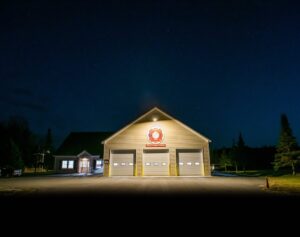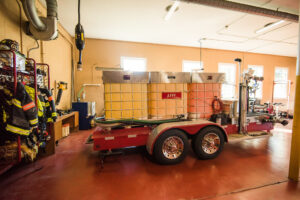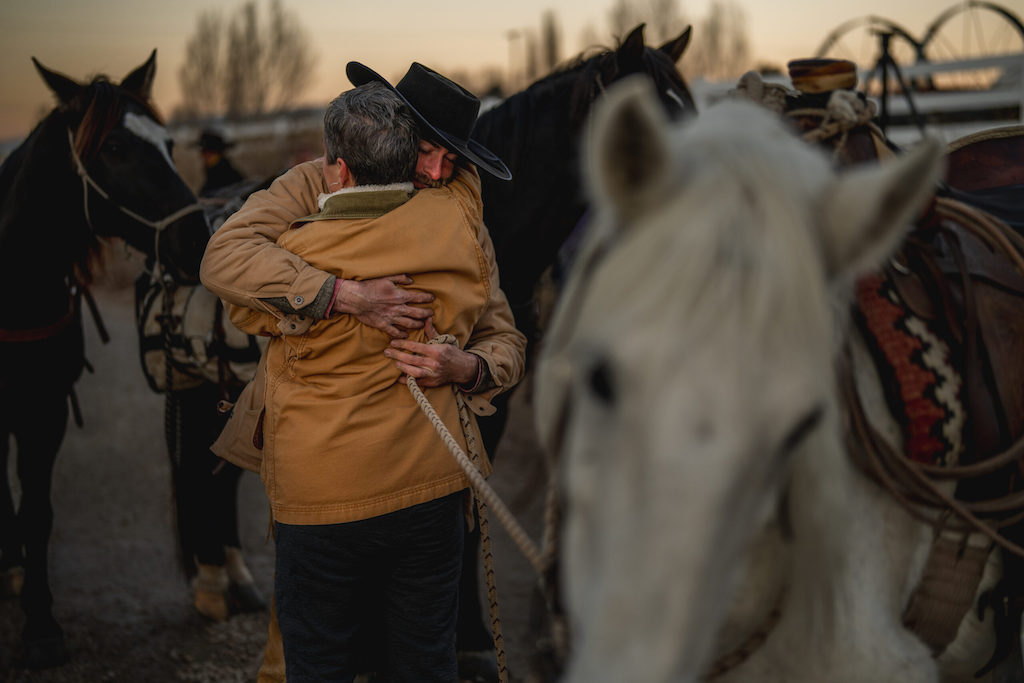
5:00
News Story
Utah horseman rode 6,000 miles through 25 states to spotlight the wild horse crisis
5:00
News Story
Utah horseman rode 6,000 miles through 25 states to spotlight the wild horse crisis
Jake Harvath hugs his mother, Leah, as he arrives at Sage Creek Equestrian in Charleston on Thursday, Dec. 5, 2024, completing a 6,000-mile, 14-month ride around the U.S. (Spenser Heaps for Utah News Dispatch)
Jake Harvath hugs his mother, Leah, as he arrives at Sage Creek Equestrian in Charleston on Thursday, Dec. 5, 2024, completing a 6,000-mile, 14-month ride around the U.S. (Spenser Heaps for Utah News Dispatch)
This story first appeared in the Utah News Dispatch.
Motorists roared by in the comfort of their modern modes of transport, but the trio clip-clopped along unphased, not even by the loudest semitrailers. They were on their last leg of what’s been a 14-month, 6,000-mile journey across the country. Just three more miles along a highway was nothing compared to what they’d already overcome.
They dipped down side streets and neighborhoods wherever they could along their route to avoid the busy highway, but got help from a police escort along Main Street in Heber City, where traffic was most hectic for three horses and one cowboy.
After passing through 25 states — from Utah to the coastline in New Jersey and back — braving busy roads, navigating remote backcountry trails, trudging through blizzards, even taking a harrowing swim across the Delaware River, and at times knocking on doors to ask for safe places to sleep and eat, Jake and his horses’ ride was almost at an end.
Jake coined the journey the “Year of the Mustang.” His mission? Raise awareness of the power and plight of the wild horse. How grazing, population growth and development pressures have made life increasingly difficult for these animals, even though they’re idolized as a patriotic symbol for their role in helping settle the West.
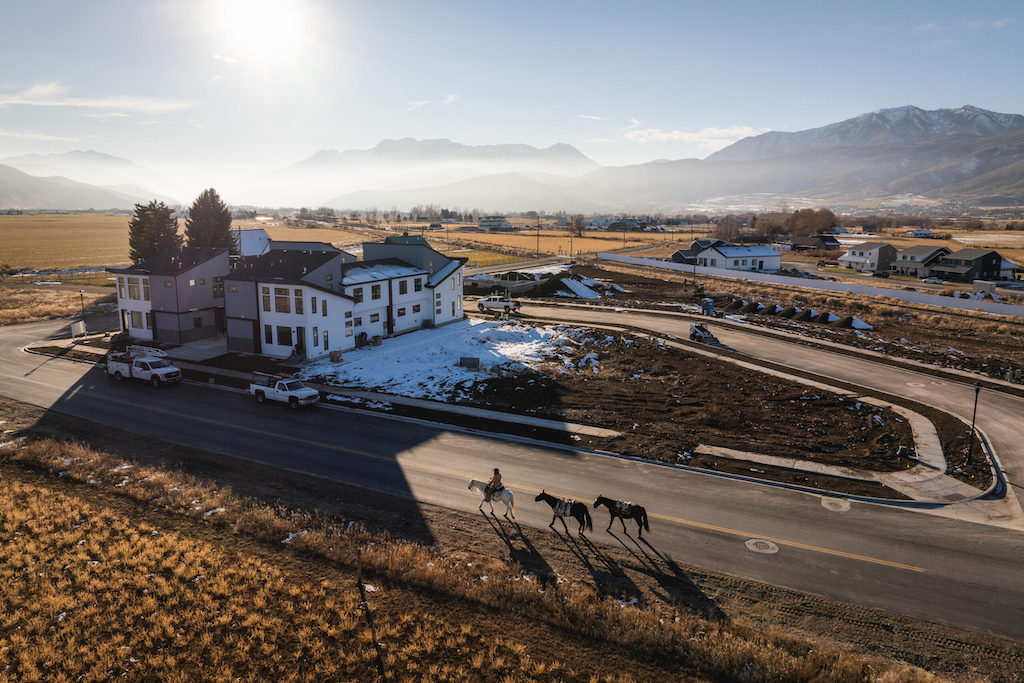
Traffic, as it turns out, would be among the biggest challenges Jake said he confronted along his ride, and it was representative of the entire issue he wanted to highlight — how wild horses “feel constricted and out of place in a human world.” That’s fitting, given the automobile has replaced the horse as a practical use in today’s reality.
“That’s the struggle of wild horses, isn’t it?” he told Utah News Dispatch in an interview reflecting on his journey.
But by proving their mettle with a modern-day cross-country ride, Jake hoped to inspire others to consider adopting a Bureau of Land Management mustang as one of the many needed solutions to the complex wild horse crisis. Last year, the BLM spent nearly $159 million on efforts to manage wild horse and burro populations across the U.S. — and yet, at more than 73,000 as of March of this year, their numbers continue to be triple what the federal government has deemed as sustainable.
To show the country how valuable mustangs are as both companions and work horses even in today’s modern world, Jake rode his steeds all the way to the Atlantic Ocean and back. He hoped to prove they’re just as capable and trustworthy as any other breed — and that they make especially tough trail horses because their survival depends on it in the wild.
All three of Jake’s mustangs were adopted from the BLM — Bella and Denver from Nevada, and Eddy from New Mexico. Their ages and training levels varied, though, at the start of their journey. Bella, now 18, was the oldest and most experienced. She helped teach Jake when he first started learning how to be a horseman at the age of 14, and they formed a tight bond, leading her previous owner to eventually gift Bella to Jake.
Eddy, 13, was previously trained but he was the newest to Jake’s herd, so the two were still learning to trust each other as their ride began. And Denver, now 7, was the youngest and a rookie. Even in the days leading up to their trip, Denver still had a lot to learn about being a pack horse, and Jake was still training him.
Now, though, after 6,000 miles, they’re all experts.
As they drew closer to her home barn, Sage Creek Equestrian Center in Charleston, Bella’s ears perked up and she began sniffing the air. Her pace quickened. From atop her back, Jake noticed her anticipation build.
“She smells home,” he said.
The homecoming
Down the road, about 30 people — friends, family and fellow horse people — gathered at Sage Creek Equestrian Center to wait for Jake’s grand arrival. A little over a year ago, on Sept. 25, 2023, Jake, Bella, Denver and Eddy had first begun their journey from this barn. On the evening of Dec. 5, they ended their ride there too.
Jake’s mom and dad, Leah and Daniel, and his brother Logan anxiously awaited his arrival.
Though Jake did the riding, all three of them played a role in the “Year of the Mustang.” Daniel helped his son map his route — a trickier task than one may think. Logan edited the countless hours of video Jake sent to document his trip. And his mom, Leah, helped manage his social media accounts, which have grown from maybe a couple hundred followers last year, to now over 81,000 on Instagram alone.
“He’s planned for this his whole life,” Leah told Utah News Dispatch as she waited, adding that she’d never been that worried for her son because she believed in him and his horses.
She exuded pride — saying she witnessed her son “flourish” over the past year — but also a sense of sadness for the journey coming to an end.
“It’s still sort of hard to believe that it ever happened and that now it’s over,” she said. “I’m both thrilled that it’s done and he was successful and safe, and that everybody got home in one piece. But it’s also a matter of processing what this looks like now for all of us going forward.”
When Jake, Bella, Denver and Eddy rounded the corner and strode down the gravel driveway to Sage Creek, his supporters clapped and cheered. “Welcome back, Jake!” a woman called. “Ride ‘em cowboy!” another shouted.
“It’s good to be back,” a grinning Jake yelled, prompting more cheers and whistles. Some of the barn’s other hoofed residents whinnied from their stalls.
Jake brought Bella to a halt and dismounted. He patted her on the neck, and she nestled her head into his chest, sharing a brief moment together before turning their attention to the welcome party.
“Six thousand miles!” someone shouted, as Jake and his mother embraced, and the crowd cheered again.
Tears rolled down Leah’s face as she hugged her son. His father then threw his arms around Jake, his face contorting with emotion. Jake rested his head on his dad’s shoulder for a long moment while his three horses stood by.
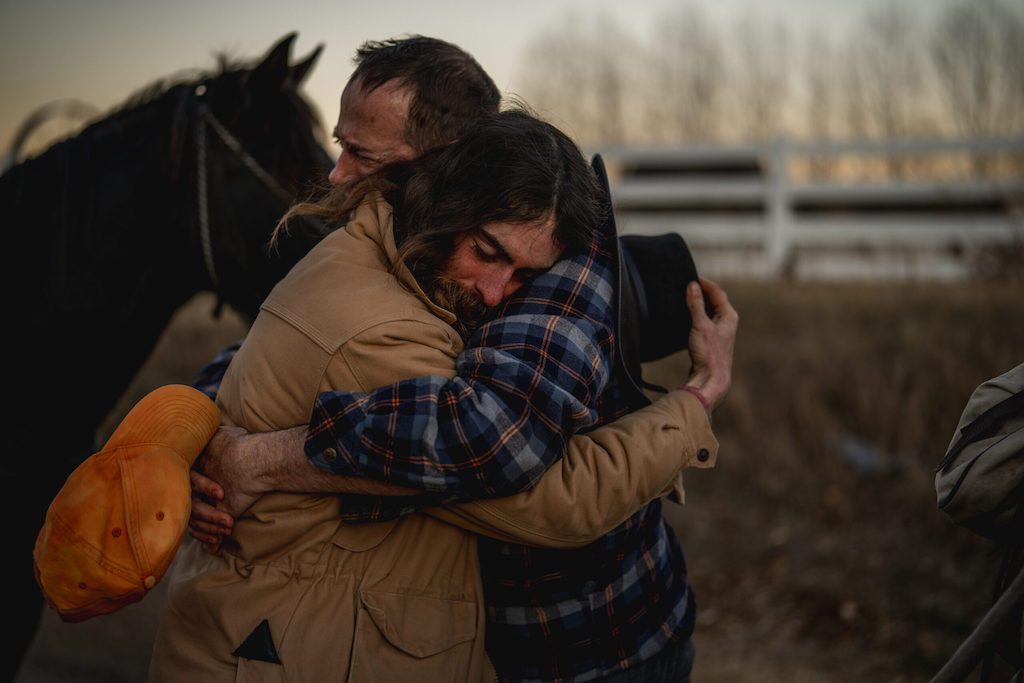
While doling out more hugs, Jake and his dad led his three horses to Sage Creek’s indoor arena, where Jake waited for the crowd to quiet down before giving a heartfelt speech, thanking them for their support and sharing his gratitude.
“I’m shaking,” he said. “I can’t believe it. It doesn’t feel real.”
Jake said it’s been a “remarkable experience, being able to help loads of people start the adoption process to adopt their first wild horses. And also just to be some people’s first experience with horses.”
A shattered record?
Alongside to his goal to raise awareness of the wild horse crisis, Jake also set out to possibly break a record for the longest continuous horse pack trip done in the U.S. within a year’s time.
Although he had originally aimed to trek 7,000 miles — with a route that crossed through California before heading back to Utah — Jake changed his plans when he realized it would be difficult to make it back to Utah before winter fully descended in the West.
It took him a little over a year, but he still rode 6,000 miles. And based on what he’s been able to research, Jake believes he has indeed set a record for the longest continuous ride in the U.S. within a year. From Sept. 25, 2023, to Sept. 25, 2024, he said he rode 4,570 miles.
These horses have suffered, bled, worked, and sweat to no end to get us here to the end, through storms, rivers, over hundreds and hundreds of mountains. They’ve proven their worth again and again. I owe my very life to them.
– Jake Harvath
The most comparable documented horse ride Jake has been able to find was one completed by Lucian Spataro in 1989. In 150 days, Spataro rode 3,000 miles coast to coast, from Los Angeles to Chesapeake Bay, Maryland, according to his website. He crossed through 15 states — the most ever done at the time with the same horses.
Jake said he plans to submit an application to The Long Riders Guild, as well as one to Guinness World Records to set an official record. It remains to be seen if they’ll accept it. But to Jake, while the record would be a cherry on top, it wasn’t the point.
The horses were.
“These horses have suffered, bled, worked, and sweat to no end to get us here to the end, through storms, rivers, over hundreds and hundreds of mountains,” Jake told his supporters. “They’ve proven their worth again and again. I owe my very life to them.”
An ‘ambassador’ for the wild horse crisis
Gus Warr, wild horse and burro manager for the BLM’s Utah office, came to Jake’s homecoming celebration. After Jake’s speech, Warr stood next to him in the indoor arena, thanking him for his work to “bring exposure” to the wild horse crisis while proving mustangs have a “long list” of capabilities, including “endurance, adaptability, stamina, love and partnership.”
“The mustang is another horse. It’s another member of people’s family that can do anything a domestic horse can do,” Warr said. He told Jake, “You’ve proven to the world that, you know what, they’re there for everybody.”
Warr told Utah News Dispatch that Jake was the best “ambassador” for the BLM’s wild horse and burro adoption program the government could ask for, at no taxpayer expense.
“We have animals we need to find homes for,” Warr said. “And he’s been a banner for that.”
As of the BLM’s last monthly report issued in September, nearly 63,000 horses were in “off range” holding facilities, cared for in either corrals or pastures. The BLM is tasked with the “management and protection” of both wild horses and the health of public lands.
Despite efforts to reduce overpopulation — including round ups and fertility control treatments — wild horse and burro populations remain about three times what federal range managers believe is an appropriate balance with rangeland resources, at about 27,000. Since 2013, herd sizes have more than doubled, though in 2020 populations dipped slightly, according to the BLM.
Some wild horse activists advocate against round ups, saying they can be cruel and mustangs have been made scapegoats for rangeland damage most often caused by taxpayer-subsidized cattle grazing. The BLM says it doesn’t remove wild horses to simply make room for cattle grazing on public lands — but rather it does so to “ensure rangeland health” in accordance with land-use plans and to carry out the BLM’s mission to manage public land for multiple uses while also protecting the land’s resources.
Still, it’s an expensive problem. Of the $158 million the BLM spent last year alone, $109 million was to care for the animals in off-range holding facilities. While fertility treatments are also expensive and difficult to administer, the agency relies on rehoming horses to save taxpayer money and reduce herd sizes.

In 2023, the BLM reported it placed about 8,000 animals into new homes (the second-highest placement rate in more than 20 years), which it estimated saved taxpayers about $181 million.
Jake said he sees adoption as not the only solution, but an important one to the wild horse crisis.
“The BLM will of course need to apply multifaceted means to controlling wild horse populations if they want to get to stable numbers that the land can sustain, and that means applying perhaps more effective and more supportive means of contraception in mares,” Jake said, as well as “finding more off-range pasture contracts so that more horses in holding facilities can just be retired to a better living situation and they can live more like wild horses do but not competing with other species.”
Along with adoption and other methods, Jake said “that will be what it takes to overcome” the issue. Though he acknowledged adoption isn’t the best solution for a majority of horses, he said it’s how more Americans can be part of the solution. While mustangs may be perceived as dangerous or uncontrollable, he wants to encourage existing and perhaps future horse owners against disregarding them in favor of other breeds.
“That’s something I think the horse world needs to acknowledge,” Jake said. “That there are qualities these horses have that are absolutely very desirable for many horsemen, and for that reason they should be counted as something worthwhile for horse owners.”
Adoption, Warr agreed, is a “huge part of solving the problem,” because the BLM can “only do so much fertility control.”
“They’re wild animals. We literally cannot inoculate, capture, vaccinate all the animals we need to,” he said. “It’s overwhelming. So we’re going to continue to do gathers, which means we’re going to have excess animals we’re going to need to find homes for.”
Jake’s efforts have indeed directly raised interest in the BLM’s adoption program, Warr said, adding that he’s been contacted by dozens of people “from all over the country” asking about it after they saw Jake on social media, in the news or in person. Jake’s journey also made dozens of local headlines throughout the year.
“Him bringing exposure to it is going to help find homes for probably thousands of animals,” Warr said.
To those who argue wild horses should just be left alone on rangelands and their populations will naturally regulate, Warr said the BLM would be neglecting its government mandate to maintain public lands for multiple uses while balancing rangeland health. Additionally, he said overpopulation could lead horses to starve, suffer and die.
For both of those reasons, he said, “We can’t turn our back on them.”
Adoption, though, has its own challenges. Americans, too, are facing increased cost-of-living pressures — and of course not everyone can afford to own a horse. They’re a luxury item, and it’s a lifestyle that’s becoming increasingly out of reach. Over his 30 years with the program, Warr said it’s become more difficult to adopt out animals.
“It’s definitely part of the equation,” Warr said. “People aren’t using equines like they used to, and it’s getting to be a challenge.”
That’s why Jake’s efforts to inspire, he said, may be more important than ever.
The journey
A little over a year ago when he first embarked on his trip, Jake’s face was clean shaven. For his return, he sported a grizzly beard and a weather-worn face.
“He came back a mountain man,” one of his supporters remarked with a laugh at his welcome home party.
His horses changed, too. When they first embarked on their trip last year, the youngest, Denver, was still learning the ins and outs of packing. And Eddy, while he was a more experienced trail horse, was still getting to know and trust Jake. Now they’ve both got 6,000 miles of experience in the backcountry through all types of terrain — desert, mountains, snow, rivers, and busy city streets.
Jake estimated he’d ride about four to six days a week with weeklong breaks in Arkansas and New Jersey. He said they averaged about 20 miles a day for the entire trip, though some days were shorter or longer.
Remarkably, Denver and Eddy completed the entire ride, switching between carrying Jake and his belongings, and Jake said he never used a trailer to move his horses forward for any portion of their journey. Bella, however, at 18 years old, worried Jake several months into their ride when he saw she was losing weight.
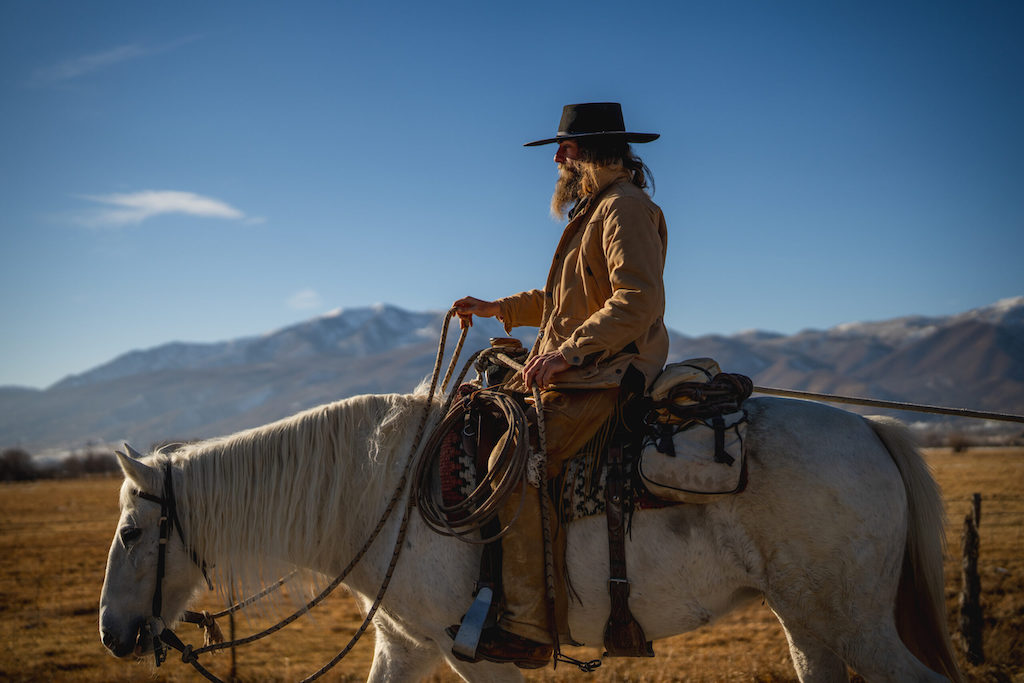
Not wanting to risk her health, Jake arranged a trailer in Arkansas to take her back home to Sage Creek Equestrian Center so she could rest. She returned in March and quickly recovered, Jake said.
But hoping to finish out the ride with Bella — the seasoned trail horse that helped teach Jake when he was first learning to be a horseman — one of his friends brought her to the Wyoming-Utah state line. She joined Denver and Eddy to trek the last 115 miles or so of the trip.
“It was so cool to get her back to be with us for the last week,” Jake told Utah News Dispatch in an interview the day after his homecoming, reflecting on the integral role Bella played.
“She was the horse — really the only horse that was truly ready when we got going. The other two had a lot to learn still,” he said. “And I look back and I realize, if it hadn’t been for her, we just never would have made it from the beginning. She taught those boys how to do their job.”
That training and trust was put to the ultimate test in Pennsylvania, when Jake’s plans to cross the Delaware River by riding his horses across the Washington Crossing bridge fell through. He said New Jersey bridge commission officials would not give him permission to bring his horses on the pedestrian path.
“My heart sank,” he said, since it was the only way he could get to his destination in New Jersey, where he planned to conclude his trek east at the coastline in Middletown. Otherwise, he’d have to trailer, which wasn’t consistent with his goal.
So, Jake said he decided to use satellite imagery of the Delaware River to find a place to cross like “real cowboys,” as he said in a video from that day posted on his YouTube channel — by swimming. “I think we’re going to go for it. Like the old days, folks.”
Jake was grinning before he, Eddy and Denver took the plunge. Then the video cut to him emerging from the river soaking and breathless. He praised his horses, laughed with relief, and poured water out of his boots before telling the camera: “That was not easy. I wish I could have filmed that for you guys but that was not a time to be holding a phone.”
Recalling the swim months later, Jake said it was an “incredible story that everyone loved,” but he added it was an “extremely risky and scary experience.” The rocks were slippery and the current was strong, threatening to sweep them down the river. Eddy and Denver were hesitant at first, but he said he steered them straight until their hooves lifted off and they were both swimming.
“I had to commit, there was no turning around,” Jake said. “If I had any shot of getting it done at all, I had to be completely confident. And that’s what I applied to everything we had to overcome.”
How ‘Year of the Mustang’ brought people together — even in an election year
As much as the Year of the Mustang was about the mustangs themselves and the special relationships they can form with humans, its success also relied on human relationships — not just friends and family, but also complete strangers.
“One of the things that surprised me most about the Year of the Mustang journey,” Jake told his supporters, “was the people who wanted to help us. Everywhere I went.”
Jake said his trip could not have been possible without the help he received along the way — the farmers, ranchers and other “horse people” who let him camp overnight on their property, in their barns or stay in their homes. With each state he passed through, Jake said he relied on a network of support that grew thanks to social media and word of mouth. His GoFundMe page also pulled in donations to fund the trip, topping $38,000.
Some nights Jake said he’d even have to knock on doors to ask for a place to stay, which he said was rarely rejected. In all, he guessed several hundred people helped him along the way. While he estimated he spent about a quarter of the 437-day trip camping on public land, the rest of the time he said he relied on “people’s private situations, whether that was camping on their land or staying in a barn.”
“I always thought this out in my mind as a very solo experience, but it became a very national effort, in a way,” Jake said, adding that he found himself talking to groups about the wild mustang crisis and advocating for their adoption.
“Maybe that’s a lot to say, but it definitely felt that way when I was speaking to the masses about wild horses,” he said. “I’m glad I got to share with everyone and to see how many people wanted to be a part of it as we went along — whether they were helping us or wanted to help me spread the word.”
Jake had planned for years to do this ride, so he didn’t intentionally plan it for a presidential election year — a time when American polarization is on full display — but it happened to work out that way. Especially as November came around, Jake said that reality was “definitely” noticeable because “it was on everyone’s mind.” He said political differences never really became an issue, though he recognized he was mostly dealing with people from similar backgrounds: farmers, ranchers and other horse people.
“I’m one of the personalities that I can make friends with anybody, and that helped me throughout this entire trip,” he said. “So I’m very much able to sit down and talk with complete strangers, wherever they’re coming from, and find ways to get along with anybody. So I never really saw that as a challenge.”
During his welcome home party, when speaking to his supporters, Jake said even though he’d get asked all the time whether one state was better than another, “I didn’t meet a bad person.”
“And I really do genuinely believe it’s a narrative that gets fed to us,” he said. “I’ve come to find that there’s good people everywhere.”
Jake said some would wrinkle their noses when he’d explain he’d be riding to New Jersey and back, asking why he chose that state. It was a matter of logistics, he said, because he’d be able to cross one more state off his list with just three days of riding time to the ocean.
Though he ran into more obstacles, like the Delaware River crossing, Jake said he enjoyed his time there, in a state where it truly was an unusual sight to see a cowboy with two horses walking down the street.
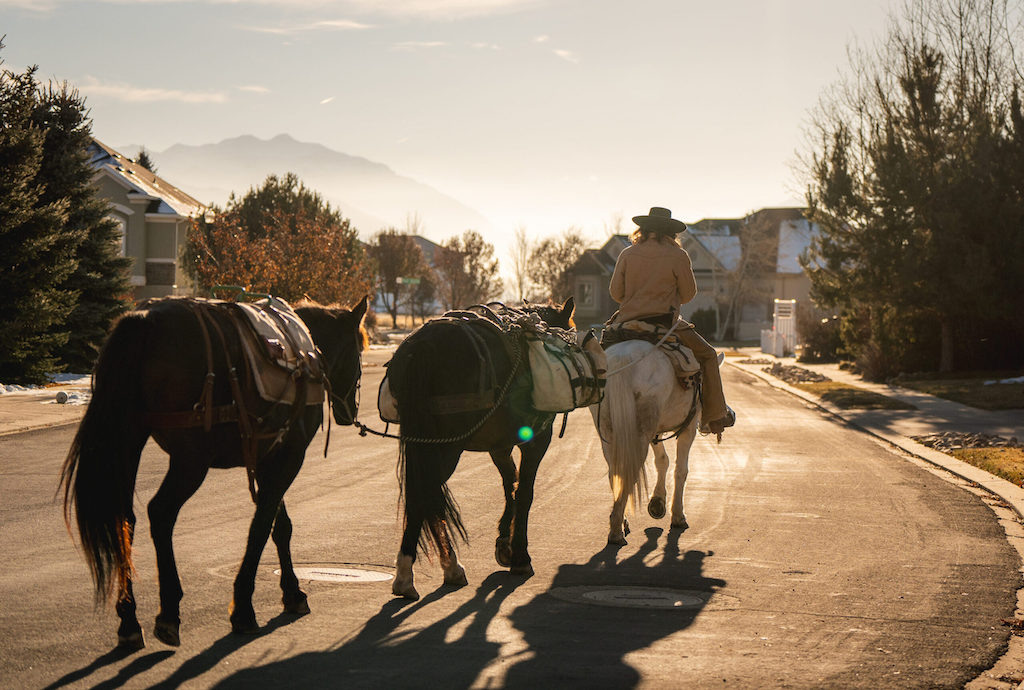
“It just brightened up everyone’s day to see horses walking through their neighborhood or down the middle of town, Princeton, and everything,” he said. “Everyone was super excited to meet me, like everywhere else. It was funny. Just the different experience and perception I got compared to what other people outside of New Jersey had.”
Though some states were more scenic than others (Colorado, he said, had the best views), Jake said he doesn’t have a favorite state.
“When you really get down to it and you’re meeting people, it’s like, you know, they’re just people,” he said. “They’re good people.”
He does have a favorite moment, though.
“It was hitting the beach,” he said, in Middletown. “When I rode those horses up to the ocean and rode them in the water, New York City in the back … it felt great.”
So what’s next for Jake now that he’s home?
He said he intends to keep advocating for wild horses, in partnership with the BLM and otherwise. He also plans to continue creating content for his social media platforms, and he hopes to make a career out of it.
“I’m going to go back out into the country. Not on horse so much this time, (I’ll) probably drive a little more, to catch other people’s stories — ranchers, horse trainers, farmers,” Jake said. “Also, going and telling my story in bigger and better ways to everyone.”
So while he may be home in Utah for now, don’t expect it to last long.
“We’re going to take this to the whole world.”
Utah News Dispatch is part of States Newsroom, a national nonprofit news organization.
YOU MAKE OUR WORK POSSIBLE.
Our stories may be republished online or in print under Creative Commons license CC BY-NC-ND 4.0. We ask that you edit only for style or to shorten, provide proper attribution and link to our website. AP and Getty images may not be republished. Please see our republishing guidelines for use of any other photos and graphics.


